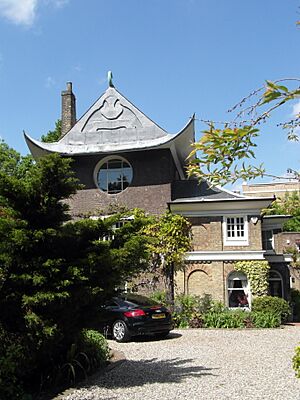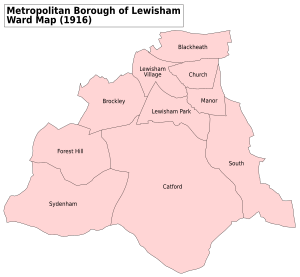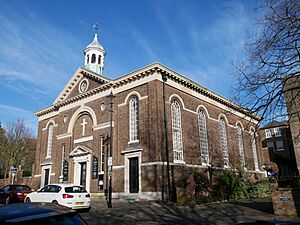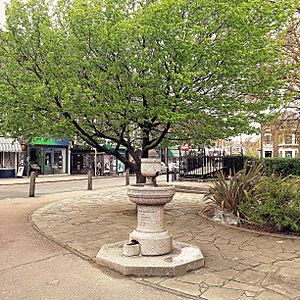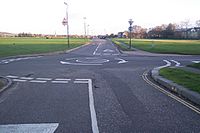Blackheath, London facts for kids
Quick facts for kids Blackheath |
|
|---|---|
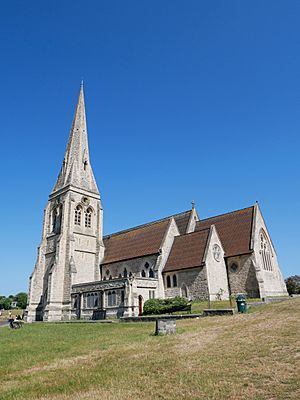 All Saints' Church, designed by Benjamin Ferrey, dates from 1857 |
|
| Population | 26,914 (2011 Census. Lewisham Ward: 14,039) (2011 Census. Blackheath Westcombe Ward: 12,875) |
| OS grid reference | TQ395765 |
| • Charing Cross | 6.4 mi (10.3 km) WNW |
| London borough | |
| Ceremonial county | Greater London |
| Region | |
| Country | England |
| Sovereign state | United Kingdom |
| Post town | LONDON |
| Postcode district | SE3, SE12, SE13 |
| Dialling code | 020 |
| Police | Metropolitan |
| Fire | London |
| Ambulance | London |
| EU Parliament | London |
| UK Parliament |
|
| London Assembly |
|
Blackheath is a cool area in Southeast London. It sits right on the edge of two boroughs: Greenwich and Lewisham. Long ago, it was part of the county of Kent. It's about 1 mile northeast of Lewisham and 6.4 miles southeast of Charing Cross, which is the traditional center of London.
The area has a big open space called the heath. Nearby are Greenwich Park and famous places like the Greenwich Observatory. This is where the Prime Meridian (the line that divides east from west on maps) is located. Blackheath railway station is just south of the heath.
Contents
History of Blackheath
What's in a Name?
The name Blackheath comes from old English words: 'blæc' (meaning dark or black) and 'hǣth' (meaning heath). In 1166, it was called Blachehedfeld, which meant "dark heath field." Some people think it got its name from the dark soil or because it was a windy, open place.
There's a story that Blackheath got its name from the Great Plague in 1665 or the Black Death in the 1300s. This is just a myth! The name was around long before those events. However, it's possible there were burial pits here during the Black Death because Greenwich was a busy village and port.
Ancient Discoveries
A very old path, used by Celts and later by Romans (now called Watling Street), crossed this area. In 1710, people found several Roman pots, called urns, buried here. More were found in 1803 in the gardens of the Earl of Dartmouth. These finds show that people have lived and traveled through Blackheath for a very long time.
Royal Connections
Many kings and queens, along with their important helpers, visited or lived near Blackheath. Before Greenwich Palace and the Queen's House were built, Eltham Palace was a popular royal home, about 2.5 miles southeast.
On the north side of the heath is Ranger's House. This is a beautiful red brick mansion from the Georgian era. It was once the home of the person in charge of Greenwich Park. Today, it holds the Wernher Collection of art.
Another special home is The Pagoda, built in 1760. It was designed to look like a traditional Chinese pagoda. The Prince Regent (who later became King George IV) used it as a summer house.
A Place for Gatherings
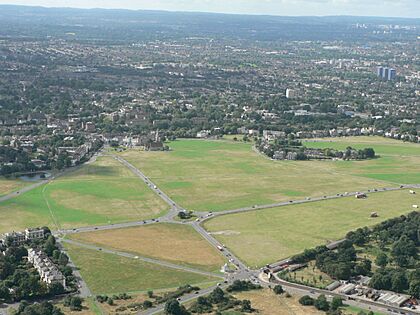
Blackheath was a popular meeting spot for big events and protests.
- In 1381, Wat Tyler gathered his followers here for the Peasants' Revolt.
- In 1450, Jack Cade led his Kentish rebellion from Blackheath.
- In 1497, Cornish rebels camped here before a battle nearby.
Important people also met here. In 1400, King Henry IV of England met the Byzantine Emperor. In 1415, the mayor of London and many citizens came to Blackheath to welcome King Henry V of England home after his victory at the Battle of Agincourt.
Armies also gathered on Blackheath. In 1709-1710, many tents were set up to house about 15,000 German refugees. Most of these people later moved to America or Ireland.
Because Watling Street (a main road) crossed the heath, it was a famous place for highwaymen (robbers) in the 1600s and 1700s. They would stop stagecoaches traveling to other parts of Kent and the Channel ports.
Vanbrugh Park Area
The Vanbrugh Pits, also called the Dips, are on the northeast side of the heath. These used to be gravel quarries but are now covered in plants. This area and the nearby neighborhood, Vanbrugh Park, are named after Sir John Vanbrugh. He was a famous architect who designed Blenheim Palace. He had a large house here called Vanbrugh Castle.
Blackheath Park Area
Blackheath Park is an area with many beautiful old homes. It was developed in the late 1700s and early 1800s by John Cator. You can see large Georgian and Victorian houses here. One famous row of houses is called The Paragon. Morden College, a historic building from 1695, is also in this area.
The Anglican church here, St Michael & All Angels, has a very tall, thin spire. People sometimes call it the Needle of Kent. There's also Our Lady of Christians Church, a Catholic church built in the 1890s. It has amazing stained glass windows.
Other Churches
The Church of the Ascension is another important church in Blackheath. It was first started in the late 1600s. It has been rebuilt and changed over the years, with parts of it dating back to the 1750s.
Who Owns the Heath?
The management of Blackheath is shared by the Lewisham and Greenwich councils. They look after it for everyone to enjoy. Long ago, the heath was mostly used for digging up gravel, sand, and chalk.
Sports and Fun
Blackheath has a long history with sports!
- In 1608, golf was supposedly first played in England here. The Royal Blackheath Golf Club, one of the oldest golf clubs, was founded in 1766.
- The first hockey club was also started in Blackheath in the mid-1800s.
Cricket has been played on the heath for centuries. The Greenwich Cricket Club played here in the 1700s. Today, the Blackheath Cricket Club is still active.
Blackheath Rugby Club, started in 1858, is one of the oldest rugby clubs in the world! They even helped organize the world's first rugby international match between England and Scotland in 1871. The club was also one of the founding members of the Football Association in 1863.
Blackheath is famous as the starting point for the London Marathon. This big running event connects to the area's history with athletics, as the Blackheath Harriers running club was formed here in 1869.
You can also often see people kite flying on the heath, enjoying the open space.
Nature and Geography
Blackheath is one of the biggest areas of common land in Greater London. It has about 85 acres of protected open space. The heath is managed by the Lewisham and Greenwich councils.
On the Greenwich side, you'll find the Long Pond, also known as Folly Pond. On the Lewisham side, there are three ponds, with Hare and Billet pond being the most natural. The heath has special areas of grassland that are home to rare wild plants.
In the 1700s and 1800s, a lot of gravel, sand, and chalk were dug up from the heath. This left large pits. After World War II, some of these pits were filled with rubble from bombed buildings. Today, these areas are covered with grass.
 |
Deptford | Greenwich | Charlton |  |
| Lewisham | Shooters Hill | |||
| Lewisham | Lee Green | Kidbrooke |
Community Life
Blackheath has two main areas for shops and fun. One is called the "Village," near Blackheath railway station. The other is "the Standard" in the north, named after the Royal Standard pub.
Near the railway station, you'll find Blackheath Conservatoire of Music and the Arts. This is a place where people can learn music and art. Close by are Blackheath Halls, a concert venue.
For many years, Blackheath hosted a huge annual fireworks display around Guy Fawkes Night in November. This event was very popular but stopped in 2020 due to the COVID-19 pandemic and later due to funding cuts.
From 2014 to 2019, Blackheath also hosted the On Blackheath music festival. Many famous bands and artists performed there, like Massive Attack, Elbow, and Grace Jones. The festival was also canceled during the COVID-19 pandemic.
Getting Around
Trains
Blackheath station has trains that go to central London places like London Victoria, London Charing Cross, and London Cannon Street. You can also get trains to other areas like Dartford and Gravesend.
Westcombe Park station serves the northern part of Blackheath. Trains from here go to places like Luton (via London Blackfriars) and Rainham.
Buses
Many London Buses routes serve Blackheath, connecting it to lots of other areas. You can catch a bus to places like Greenwich, Lewisham, Canary Wharf, Stratford, and Woolwich.
Images for kids
See also
 In Spanish: Blackheath (Londres) para niños
In Spanish: Blackheath (Londres) para niños



